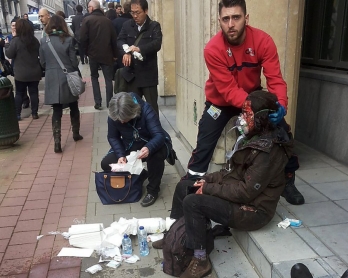Debunking the bushfires disinformation inferno
Sydney -- A satellite photo showing the extent of Australia’s bushfires? No, a graphic generated using NASA’s data.
A kangaroo cuddling up to researchers after escaping the fires? No, he was actually thousands of miles away from the blazes, hugging a carer at a wildlife sanctuary.
Wombats showed “real leadership” during the crisis by inviting other animals to hide in their burrows? They’ve allowed intruders in their burrows for eons.
As the bushfires spread with unprecedented speed and ferocity in Australia, so had misinformation. In fact the cesspool of rumours, hoaxes and conspiracy theories matched the infernos in their intensity and scale.
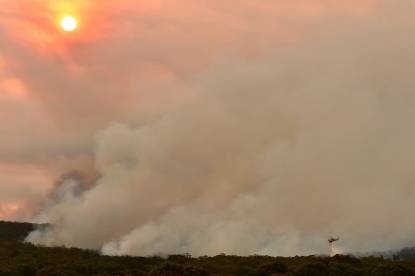 A helicopter drops water onto a large bushfire in Bargo, 150km southwest of Sydney on December 19, 2019. (AFP / Peter Parks)
A helicopter drops water onto a large bushfire in Bargo, 150km southwest of Sydney on December 19, 2019. (AFP / Peter Parks)Which kept me and my colleagues quite busy.
As an editor for AFP’s Digital Verification team in Australia, my job is to spot and debunk misinformation related to our area. Our team tracks social media to see what posts are being shared the most. If a widely-shared post looks iffy, we check it out. If we find that it carries false or misleading information, we publish our findings on our fact-check blog.
We try to be as topical and as relevant as we can, as the key in gaining the upper hand in information warfare is to be fast enough to spot and debunk a piece of misleading content, call out the wrongdoers and stop the misinformation before it makes too much of an impact.
So when the fires first started being in the news, the first thing I did was polish our pre-curated lists on Twitter and CrowdTangle to better track the online trends and sentiments on the topic.
I also started doing searches related to the fires. Experience has taught us that rumours, hoaxes and conspiracy theories usually take time to form and circulate online.
 A red sky due to smoke from bushfires hang over the town of Jindabyne in New South Wales on January 4, 2020. (AFP / Saeed Khan)
A red sky due to smoke from bushfires hang over the town of Jindabyne in New South Wales on January 4, 2020. (AFP / Saeed Khan)Misinformation related to the fires took a bit of time to really get going. At the height of the blazes at Christmas and New Year, for example, most online users seemed to be focusing on the government’s mishandling of the crisis.
But shortly after a particularly severe round of fires in late December, the disinformation flared as well.
 The afternoon sky glows red from bushfires in the area around the town of Nowra in the Australian state of New South Wales on December 31, 2019. (AFP / Saeed Khan)
The afternoon sky glows red from bushfires in the area around the town of Nowra in the Australian state of New South Wales on December 31, 2019. (AFP / Saeed Khan)We started to pick up a sea of misleading claims, involving doctored images, old photos being described as new, misleading fire maps of Australia, computer-generated graphic said to be a real photograph taken from space, as well as claims attacking the government’s lack of protection for the country’s unique flora and fauna -- more than one billion animals were said to have perished in the flames this season alone.
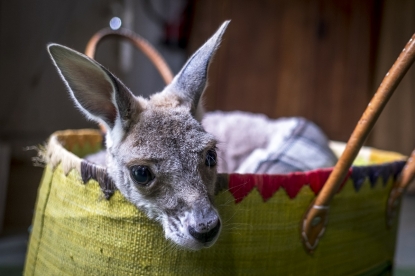 Diego, a six-month old kangaroo who prematurely left his mother, sits in a wool bag at the Australian Parc in the French southern city of Carcassonne, on January 20, 2020. (AFP / Eric Cabanis)
Diego, a six-month old kangaroo who prematurely left his mother, sits in a wool bag at the Australian Parc in the French southern city of Carcassonne, on January 20, 2020. (AFP / Eric Cabanis)Some claims are very easy to debunk, especially when accompanied by visuals. A simple reverse image search on search engines like Google, Yandex and TinEye will show that the shared image is misleading.
So when I saw a photo of a woman and several children half-immersed in water next to a jetty alongside a claim that the family was seeking shelter from the bushfires, I did a quick reverse image search and found that it was actually shot during a separate bushfire in Tasmania in 2013.
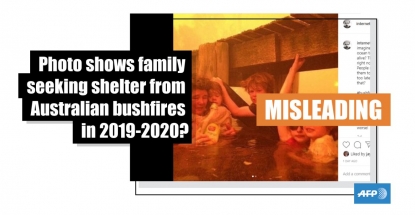
Or the image can be just plain false, like the one that was alleged to show fires in Australia from space, as taken by a NASA satellite. Turned out it wasn’t even a photo, but a computer-generated graphic.
These types of checks are fairly straight-forward and can be conducted, written, edited and published within a day.
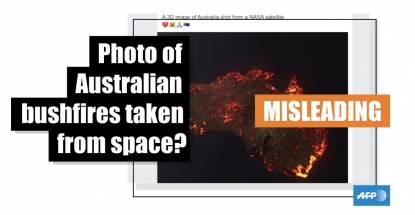
There were other more serious and outlandish claims. Some associated the Islamic State terror group with the fires, citing an old edition of the jihadist group’s magazine that encouraged its followers to set fire in the West; others pointed fingers at railway developers by comparing “graphics” that purportedly showed the eerie similarity between a proposed route for a railway project and the locations of the fires.
We didn't tackle many of these conspiracy theories. While they were naturally intriguing to readers, they lacked a clear, direct accusation backed by evidence. That made it difficult for us to identify a claim and refute it.
Instead we concentrated on misinformation that fit in with our standard formula. Each AFP fact-check starts with a clear claim or question that we can confidently say is true, false, or misleading. We document how the misinformation has spread online and how we got to our answer using resources available on the web. That way, any reader can retrace our steps and come to the same conclusion.
Another reason that we did not investigate some claims is that we did not want to give oxygen to potentially harmful content, such as the one above involving a notorious jihadist group, or to claims that we cannot conclusively debunk. If we can’t prove it’s false or misleading, we drop it.

One of the most widely-shared conspiracy theories during the bushfire crisis was accusations against the Australian Greens political party that it changed its stance as the fires spread to support hazard reduction burns and back burning (the party said it had always supported hazard reduction burns.)
Another was what one researcher called an “unprecedented” online disinformation campaign to shift blame from the fires away from climate change and onto arsonists.

Unlike the straight-forward fact-checks, unravelling conspiracy theories can take much more time. You need to spot a conspiracy theory, deduce a pattern that sends alarm bells, research enough to prove who is behind it -- all that can take anywhere for a few days to a few weeks.
It took us around two weeks to gather enough information from authorities in order to debunk claims that as many as 180 people had been charged with arson in connection to the bushfires.
Tracing activities involving a trending hashtag on the fires took even longer. The #arsonemergency hashtag started trending on Twitter when the fires picked up in early January 2020. A researcher, however, told us that the hashtag began pushing the line as early as November 2019. It took us nearly three months to comprehensively analyse the pattern and activities involving this hashtag.
 Twin Red Kangaroo joeys, 'Archie' (L) and 'Pebbles' (R), rub noses as they enjoy the sunshine at Sydney's Taronga Zoo, 01 September 2005. (AFP / Greg Wood)
Twin Red Kangaroo joeys, 'Archie' (L) and 'Pebbles' (R), rub noses as they enjoy the sunshine at Sydney's Taronga Zoo, 01 September 2005. (AFP / Greg Wood)One of the most challenging fact-checks I did during the crisis was an explainer on claims that first responders in Australia were advised to kill all orphaned koala and kangaroo joeys found during the bushfires. When tackling misleading claims that are only partly false and involve an emotive issue, we have to be extra careful in our approach and concise in our argument. In this case, information cited by the misleading posts did originate from a government document, but other supplementary government reports added that only joeys deemed unlikely to survive should be euthanised.
Instead of focusing solely on the government release, we cross-checked our report with information provided by a veterinarian who was consulted by authorities on the subject. She explained why euthanasia could be the humane choice for orphaned joeys, which added an extra layer to our story.
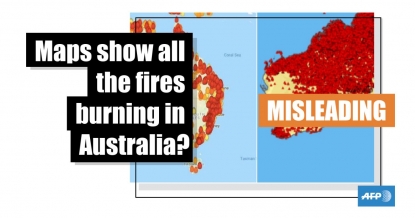
A fact-check that required some learning on the spot involved social media posts sharing some misleading fire maps in Australia. In order to better illustrate the difference between the misleading fire maps and the real locations of the fires, I learned to read and understand satellite data from NASA's Fire Information for Resource Management System (FIRMS) during a short period of time, as well as create an overlay and a gif using comparable data from the space agency.
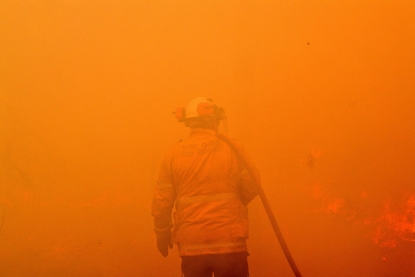
The bushfire crisis was an extremely busy time for our team. Fact-checkers are usually unfazed by the volume of misinformation, since there is so much out there. But we were under self-imposed pressure to get our stories out as soon as possible to try to curb the spread of untrue information before it caused more panic and confusion at such a difficult time.
I think we did a good job. And judging by the feedback that we received, readers did too. "Great that you're fact checking claims. Hoaxes and fake news are dangerous. Thank you".
This blog was edited by Yana Dlugy in Paris.
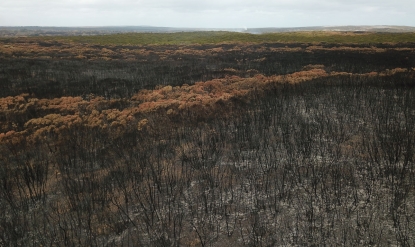 An aerial photo taken on January 16, 2020 shows a fire damaged landscape on Kangaroo after bushfires ravaged the island off of the south coast of Australia. (AFP / Peter Parks)
An aerial photo taken on January 16, 2020 shows a fire damaged landscape on Kangaroo after bushfires ravaged the island off of the south coast of Australia. (AFP / Peter Parks)



